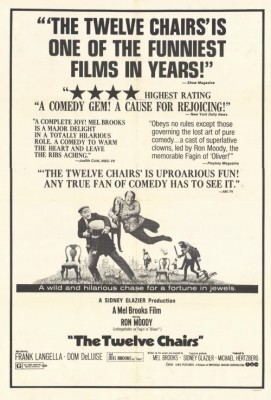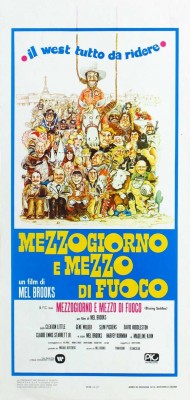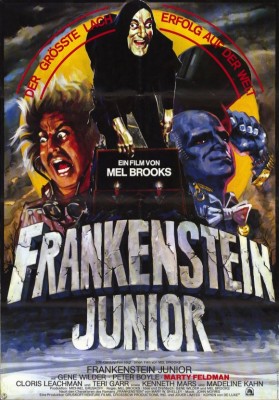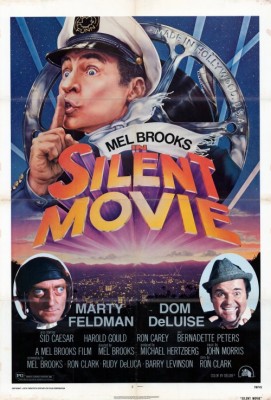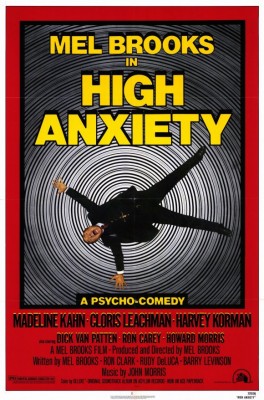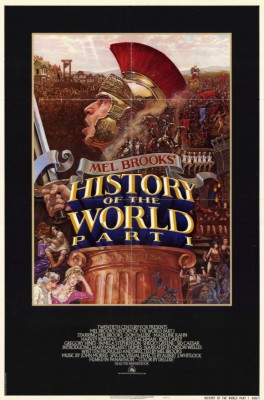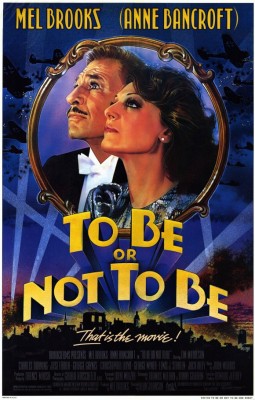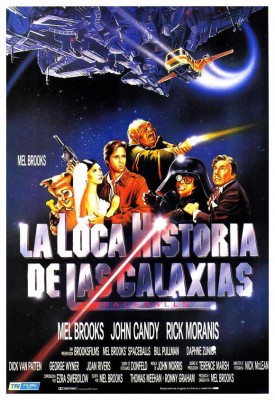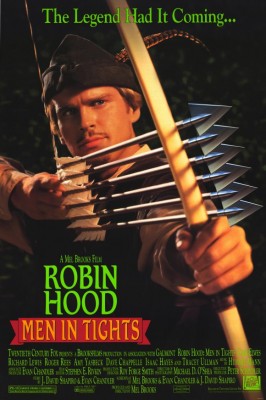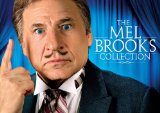| Reviews & Columns |
|
Reviews DVD TV on DVD Blu-ray 4K UHD International DVDs In Theaters Reviews by Studio Video Games Features Collector Series DVDs Easter Egg Database Interviews DVD Talk Radio Feature Articles Columns Anime Talk DVD Savant Horror DVDs The M.O.D. Squad Art House HD Talk Silent DVD
|
DVD Talk Forum |
|
|
| Resources |
|
DVD Price Search Customer Service #'s RCE Info Links |
|
Columns
|
|
|
Mel Brooks Collection (12 Chairs/Blazing Saddles/Young Frankenstein/Silent Movie/High Anxiety/History of the World and More!)
While Blazing Saddles, Young Frankenstein, and Spaceballs are already out in high-def, it's nice to see lesser gems like The Twelve Chairs and Silent Movie receive excellent transfers. Extra features are scattershot; The Twelve Chairs has virtually none, while others are packed to the rafters with supplements, but there is a fair amount of new material, and all of it is in high-def.
Brooks' follow-up to The Producers is his most conventional, least-known comedy, but The Twelve Chairs has through the years developed something of a minor following. The enormous success of Blazing Saddles and Young Frankenstein a few years later would type Brooks as a director of film genre parodies, an unfair and not really accurate label for reasons described below, making this atypical effort all the more fun to watch today.
The story is based on an oft-filmed 1928 Russian novel by Ilf and Petrov also called The Twelve Chairs (well, actually 'Двенадцать стульев'). Films as varied as It's in the Bag! starring radio rivals Jack Benny and Fred Allen, worked from its basic premise. The year before Brooks's film opened another adaptation, The Thirteen Chairs, was directed by Nicolas Gessner; that Euro-comedy featured a strange jumble of talent including Sharon Tate, director-actors Vittorio De Sica and Orson Welles, and character star Terry-Thomas.
In Brooks' version, impoverished Russian nobleman Ippolit Vorobyaninov (Ron Moody), having fallen on hard times since the Russian Revolution, is anxious to retrieve a fortune in jewels his mother-in-law secretly hid in one of twelve dining room chairs that have scattered to the winds across Russia since the Bolsheviks took over. Wandering grifter Ostap Bender (Frank Langella, in one of his first films) also learns about the hidden jewels, as does the Russian Orthodox (but very unorthodox) priest Father Fyodor (Dom DeLuise). The three scramble to find the booty, most of the time Vorobyaninov and Bender working together as reluctant partners, while mad Fyodor frantically searches on his own.
Filmed on a modest budget that's offset by imaginative location shooting in (less expensive) Yugoslavia, its picturesque scenery and architecture make a good substitute for early Soviet Russia. The film's main strength, and a theme Brooks would return to time and time again, is the improbable pairing of disparate types who drive each other crazy but who, in the end, become inseparable. That was certainly true of Gene Wilder and Zero Mostel in The Producers, and to a lesser degree Wilder and Peter Boyle in Young Frankenstein, etc.
Moody and Langella are both fine, the former doing something like a riff of his Fagin role in Oliver! But clearly stealing the film is Dom DeLuise in a wildly anarchic performance. DeLuise had been kicking around Hollywood for a number of years, but was rarely used well - he even turned up in, of all things, Fail-Safe (1964), in an unsympathetic straight role. No one quite knew how to make use of his unique talents; starring on his own sitcom, Lotsa Luck, DeLuise unwisely was held back essentially playing straight man to eccentric, unfunny characters. But Brooks recognized his talent, cutting him loose and for the next dozen years DeLuise bridged the gap between Jonathan Winters and Robin Williams, alternating between movies for Brooks and second banana roles opposite Burt Reynolds. (*** 1/2 out of *****)
The picture that put Brooks on the box office map, Blazing Saddles cost just $2.6 million to make (and looks it) yet earned nearly $120 million in the U.S. and Canada alone. Though remembered as a parody of movie Westerns, it's really only partly that; the film is a mélange of influences, styles, and ambitions. Typical of Brooks' output, it's technically and comedically unapologetically crude and (what today we'd call) politically incorrect, audacious, and undisciplined.
What plot there is lifted from a thousand other Westerns: a corrupt government official, Hedley Lamarr (Harvey Korman), is trying to buy up valuable land in Rock Ridge ahead of the coming railroad line. In response the governor (Brooks) appoints a new sheriff, who in a unique twist turns out to be a former black slave and railroad worker (Cleavon Little) to protect the town from Lamarr's henchmen, chiefly Taggart (Slim Pickens) and Lyle (Burton Gilliam, an unjustly forgotten '70s character actor). Bart later teams up with The Waco Kid (Gene Wilder), a drunken former gunslinger.
When the film was made, the Western genre had pretty much petered out, both in terms of the classical John Ford-Howard Hawks-John Wayne-type A-Western, and the Euro-Westerns that had blossomed in the 1960s but by the time of Blazing Saddles had themselves switched to genre parodies and were in decline. Brooks' film almost never directly references specific films and characters though the film does have some of the ambience of a high-end B-Western series entry.
Instead, Blazing Saddles uses this most traditional of movie genres as a backdrop for one taboo-busting gag after another, from farting cowboys and overtly gay chorus boys (though no gay cowboys, their cinematic debut still years away) to a steady stream of outrageously bawdy double-entendres ("Pardon me while I whip this out!") and racial slurs, most infamously the "n-word" uttered no less than 17 times during the picture. (It seemed like twice that.) Though spoken in a few comedies since then (e.g., a funny bit in The Kentucky Fried Movie) it's hard to imagine filmmakers even attempting such provocativeness in today's archly-P.C. climate.
The film caught 1974 audiences off guard; they could barely believe what they were seeing (and hearing), especially so soon after the collapse of Production Code less than a decade before. The thunderous laughter the film was greeted with was like a great en masse release of '50s staidness and repression. Conversely, the gradual marginalization of crude, flatulence-type humor may account for the picture's diminished potency. I thought it was just about the funniest movie ever made when I first saw it in the mid-1970s but my friends and I were much less impressed when it was reissued in the early-1980s. Later, as a teaching assistant on a Film Comedy course at USC, I watched as Blazing Saddles was screened for about 200 undergraduate students - seemingly the perfect audience - which was met with stony silence throughout.
Still, no matter that one corner of the film satirizes race relations while another reflects Catskills-style Jewish humor and yet another offers affectionate genre parodies, etc., the picture is unified by a common, anarchic goal and its infectious lunacy pleased audiences enormously. (*** 1/2)
Easily Brooks' most consistently successful genre parody, Young Frankenstein is an affectionate (very important) reworking of Son of Frankenstein, the 1939 Universal monster classic, with elements of other Universal horror films, particularly Bride of Frankenstein, tossed in. It may be Brooks' most cohesive work and with the right audience still plays well today.
Young Frederick Frankenstein (Gene Wilder) and his wife, Elizabeth (Madeline Kahn), travel to Transylvania to assume control of his late grandfather's estate. Discovering his infamous grandfather's old laboratory and private journals Frederick quickly becomes obsessed with continuing and perfecting his grandfather's efforts to create life from a stitched-together human corpse. With the help of hunchback assistant Igor (Marty Feldman), voluptuous lab assistant Inga (Teri Garr) and mysterious servant Frau Blücher (Cloris Leachman), a new Monster (Peter Boyle) is created. But in classic Frankenstein movie tradition there's just one problem: an abnormal brain was mistakenly used.
Released barely ten months after Blazing Saddles - the former came out in February 1974, this the following December - Young Frankenstein was likewise successful, its $2.8 million budget offset by domestic grosses of around $86 million, this despite the fact that Brooks had to fight to get the film made in black and white instead of color.
The picture's main attributes are its enormously likeable cast of disparate characters who, as in The Twelve Chairs, have little in common but are ultimately inseparable as they work toward a common goal - and the film's successful emulation of Universal's Gothic Horror house style. Adding to the verisimilitude is the appearance of Kenneth Strickfaden's original electrical gadgets, used in innumerable Universal horror and sci-fi films of the 1930s and '40s, as well as numerous serials, while John Morris's score is another major asset.
Though equally adept at scoring drama (his music for The Elephant Man, produced by Brooks, and Ironweed are both excellent) Morris became known for scoring film comedy; I recall his catchy score for The In-Laws turning up years later in trailers for other movies and elsewhere. Whatever genre Brooks turned to, Morris somehow effortlessly captured its essence musically; he remains as important to Brooks as, say, Bernard Herrmann was to Hitchcock, or Georges Delerue to François Truffaut.
Wilder, who co-wrote the film with Brooks, is superb. As he did in The Producers Wilder goes all-out, committing fully to the part; it remains one of his two or three signature roles. The rest of the cast is just great, too, especially Feldman's loony hunchback and Boyle's unique, appropriately childlike characterization. His may be the screen's best Frankenstein's Monster since Karloff's original, no small compliment. (**** 1/2)
Re-watching these movies again, in most cases for the first time in decades, Silent Movie proved to be the biggest surprise. Having watched so much silent comedy in the years since its release I was worried Brooks' picture - with synchronized music and sound effects but no spoken dialogue, with one exception - wouldn't live up to my fond memories of it, that today it would play as little more than a stunt film. Happily, it turns out to be his most under-appreciated work.
Perhaps unintentionally, Brooks and his writers made one extremely wise decision: Instead of directly emulating silent comedy of the teens and '20s as others have done, from Hollywood Cavalcade (1939) to The Great Race (1965) and beyond, an approach that almost never works for a variety of reasons, Silent Movie plays like a silent comedy made in 1976 (and in doing so reflects a post-Production Code permissiveness), as if the form never went out of fashion. Some of the sight gags are slight variations of old silent era ones but many are wholly new creations, and the film plays as very modern, not retro at all. And while there are a few racy and/or tasteless gags (including a mass erection, shocking and funny back in 1976), the characters are much more in line with '20s silent comedy types without specifically imitating any of the great silent clowns.
Mel Funn (Brooks, of course) is a famous director but recovering alcoholic, who with sidekicks Dom Bell (DeLuise) and Marty Eggs (Feldman) gets a Hollywood studio chief (Sid Caesar, Mel's old boss on Your Show of Shows) to green-light an unusual project: an all-star silent movie.
Mainly the film cuts between two subplots: the trio's efforts to land big stars like Burt Reynolds, James Caan, Liza Minnelli, Paul Newman, Marcel Marceau, and Anne Bancroft (Brooks' real-life wife) - all of whom make unbilled guest appearances, which surprised and delighted 1976 audiences.
The other subplot involves efforts by a big conglomerate, led by Engulf (Harold Gould) and Devour (Ron Carey) - a reference to Gulf + Western, then-owners of Paramount Pictures - to sabotage the film and take over the studio. Eventually they enlist the aide of femme fatale Vilma Kaplan (Bernadette Peters); Mel is so devastated when he learns of the ruse that he falls off the wagon - badly. Brooks is hilarious here (as is the frequent and funny foreshadowing leading up to this moment); the scene is like a recreation of a silent parody of a Griffith melodrama, and it's the comedy high-water mark of Brooks the on-camera movie comedian.
The picture errs here and there: somebody must have (erroneously) thought silent pictures were exhibited with no sound of any kind, and the opening moments have no music, no sound effects, no nothing. At first I thought my Blu-ray disc was defective.
By 1976, all the silent clowns were pretty much long gone; even old Harry Ritz of the Ritz Brothers, who has a funny cameo, became a film star well after the dawn of sound. And yet the game cast all give performances perfectly suited to silent comedy. Caesar, for instance, is hysterical as the bug-eyed, nerve-wracked studio boss, while DeLuise and Feldman are funny and distinctive. Character actors like Liam Dunn (who sadly died before this was released), as a newsstand owner, and Fritz Feld, as a maître d' are good in small parts. (Feld's trademark "Pop!" of his mouth gets its own inter-title.)
Many of the sight gags are quite good. For instance: the trio passes a spicy Szechwan restaurant, where through the window one can see smoke billowing from all the customers' mouths, filling the restaurant. Some of the gags reflect the New Hollywood: the door leading into Caesar's office is identified "Current Studio Chief," for instance.
In all, Silent Movie is a bright, sunny, one-of-a-kind comedy that deserves to be seen again. (**** 1/2)
The funniest thing about High Anxiety is its title, a riff on Alfred Hitchcock's Vertigo. Literally dedicated to the Master of Suspense, this affectionate spoof chiefly reworks Hitchcock's Spellbound, with elements from North by Northwest and Vertigo tossed in, though there are also scene-specific parodies from Psycho and The Birds, among others.
Brooks stars Dr. Richard Thorndyke, new administrator of the seaside Psycho-Neurotic Institute for the Very, Very Nervous - a name less funny than the sign on the gate, which reads, simply, "Keep In." At the institute, Dr. Montague (Harvey Korman) and Teutonic sadist Nurse Diesel (Cloris Leachman) are secretly bilking rich patients out of their millions. Late in the story Thorndyke, who suffers from High Anxiety, a debilitating fear of heights, becomes involved with Victoria Brisbane (Madeline Kahn), the daughter of one of the wrongly committed millionaires.
Mel Brooks is a better writer than he is a director, and he's a better director than he is an actor. (Consider, for instance, that in Blazing Saddles Brooks is a lot less funny than Slim Pickens, the real-life cowboy-turned-character actor.) Don't get me wrong: Brooks is a terrific raconteur and ad-libber, and he's okay in specialty character parts (like his smallish supporting role in The Twelve Chairs) or as part of a big ensemble (like Silent Movie, in which Mel's quite hilarious), but he's strictly a funny guy that occasionally acts, not an actor who can be funny like, say, Gene Wilder, the original choice to play Thorndyke.
While the sight of a middle-aged, balding Jew with an overbite playing the Cary Grant role (or at least the James Stewart part) is pretty funny all by itself, Brooks really isn't up to the task. It's a largely straight and reactive role, burdened with carrying the film's narrative, and Brooks-the-actor is strangely lifeless here. His big scene in the picture has him singing the title song (also written by Brooks) at a piano bar, in a performance lampooning Frank Sinatra's often-imitated style, but it comes off as indulgent instead of funny.
A few gags cleverly put a Brooksian spin on iconic Hitchcock moments: parodying The Birds, Thorndyke is attacked by a swarm of black crows - who shit all over him. But while Brooks and his writers come up with a laundry list of Hitchcock references, the movie as shot and cut together doesn't much resemble Hitchcock's style at all, except in a few shot-for-shot recreations like the shower scene from Psycho, which is more impressive for its meticulousness than its humor; the set-up to the punch-line is extremely awkward. All this is surprising considering the same team behind Silent Movie wrote it: Brooks plus Ron Clark, Rudy De Luca, and future director Barry Levinson, all of whom act in both this and History of the World, Part I. (Also in the film near the end is famed matte painter Albert Whitlock, as Victoria Brisbane's father.)
The supporting cast is all over the map, another problem. Korman and Leachman are way over the top, as if performing in front of a live audience for The Carol Burnett Show. Ron Carey, as Thorndyke's sidekick, Brophy*, and Howard Morris, as Thorndyke's mentor, Professor Lilloman, are exaggerations of '40s Hollywood character types. Another character, Braces (writer De Luca), apparently is supposed to spoof "Jaws" from the James Bond movies. (***)
Brooks is again front-and-center for History of the World, Part I, not only as Producer-Director-Writer, but also as song lyricist and star, appearing in no less than five different roles. A disjointed and - as Leonard Maltin aptly puts it - scattershot comedy, the film is basically a series of extended and desperately bawdy Burlesque-style sketches. In one sense it's really no less funny than the more celebrated Blazing Saddles or Young Frankenstein, but by this point the bloom was clearly off the rose. (The film cost $11 million and grossed $43 million - not bad, but disappointing after his '70s blockbusters.) Large swaths of the film play utterly flat, gags and concepts from earlier glories are reworked but not bettered, and the picture compares unfavorably to other spoofs of historical epics: Monty Python's Life of Brian, released two years before, was much more daring; Richard Lester's 15-year-old A Funny Thing Happened on the Way to the Forum offered better-executed slapstick; while Airplane!, released that same year, had twice the energy and five times as many laughs.
The film is divided into five main segments: "The Dawn of Man," "The Old Testament," "The Roman Empire," "The Spanish Inquisition," and "The French Revolution." However, the Roman story eats up most of the 92-minute film's running time. "The Old Testament" is little more a great single gag featuring Brooks as Moses; "The Spanish Inquisition" an excuse for Brooks to perform another intended showstopper. As Grand Inquisitor Tomás de Torquemada**, Brooks performs a wild send-up to MGM musicals, complete with an Esther Williams-esque climax featuring swimming nuns. However, it's basically an expensive reworking of "Springtime for Hitler" and probably cost not much less than all of The Producers to mount.
The Roman sequence, the heart of the picture, starts out great, with many laughs early on as stand-up philosopher Comicus (Brooks) and his agent Swiftus Lazarus (Ron Carey) befriend Vestal Virgin Miriam (Mary-Margaret Humes, who resembles a young Catherine Zeta-Jones) and Ethiopian slave Josephus (Gregory Hines). (Hines was a last-minute replacement for Richard Pryor, who badly burned himself freebasing cocaine eight days before he was to have begun filming.) There are a lot of good gags early on: a sign advertises as a "V and X-Cent Store." And in response to a Roman senator's exclaim, "Sic transit gloria mundi," another replies, "I didn't know Gloria was sick!"
Unfortunately, it's all downhill from here. DeLuise is introduced as a drunken, gluttonous Caesar and Madeline Kahn as Empress Nympho, who is; it was the irreplaceable actress's unworthy final role in a Brooks film and the segment strangely just stops without much resolution. Another Caesar, Sid, fairs somewhat better in The Dawn of Man sequence, in a series of non-speaking blackout gags ranging from poor to inspired. The French Revolution segment was filmed in England, which in part explains the surprising appearance of the great Spike Milligan in a throwaway role. Cloris Leachman and Harvey Korman turn up here, along with the indescribable Andréas Voutsinas, the original Carmen Ghia in The Producers.
History of the World, Part I's lavishness isn't equaled by its laugh quotient, but it's an undeniably handsome-looking film. Albert Whitlock's matte paintings are superb; each segment after the first begins with one or several, and they are as good as any seen in the most lavish epic. The sets, too, are big, colorful, and expensive-looking, particularly those built for the Roman segment. Orson Welles's narration adds gravitas, and John Morris's typically fine score recalls the work of Erich Wolfgang Korngold. (** 1/2)
Not long before making History of the World, Part I, Brooks formed Brooksfilms, which he set up to produce not only his own films but projects for his wife, actress Anne Bancroft, and other worthy efforts. Ironically, Brooksfilms's output was notably better than Brooks'; during the 1980s the company made My Favorite Year, Frances, The Fly, and 84 Charing Cross Road, among others - all ambitious, good films.
It was in this climate Brooks produced and starred in To Be or Not To Be, a flawed but not-bad remake of Ernst Lubitsch's superlative and unique wartime comedy, a film not appreciated when it was new but considered a masterpiece of film comedy today.
Brooks' "stock company" is in evidence - composer John Morris, writer Ronny Graham, etc. - but it was directed not by Brooks but rather a longtime associate: choreographer Alan Johnson, who had worked with Brooks going all the way back to The Producers. Not surprisingly, one of the differences between this and the 1942 film is the addition of several Broadway style musical numbers.
The original and remake are closely related with mostly the same script but a slightly different approach and perspective. Both follow a small Polish theater company before and during the Nazi occupation. The company's stars are Anna and Frederick Bronski (Brooks and wife Anne Bancroft), he a vain ham and she a great stage star. They and other members of the company become involved in the resistance movement, eventually coming to the aide of Polish flyer Lt. Sobinski (Tim Matheson), who coincidentally loves Anna, to Frederick's great annoyance.
Never one to pass up a chance to ridicule anti-Semites, especially Nazis, To Be or Not To Be you'd think would be a good match for Brooks and his sensibilities, with Bancroft one of the few actresses capable of approaching the great Carole Lombard and her delightful performance in the original film.
You'd be half-right. Bancroft is just great - funny and manipulative, sexy, and exasperated by her husband's foolishness; it's just one of a string of great later-career roles. (She followed this with four great performances in a row, in Garbo Talks, Agnes of God, 'night, Mother, and especially 84 Charing Cross Road.)
Brooks, however, utterly lacks the subtlety of Jack Benny's hilarious original characterization. Benny effectively plays a ham; it's hard to think of Brooks as anything else. The original film was stylized and artificial in some respects, especially in the early scenes, yet had the immediacy of being made at the beginning of the real World War, at a point when an Allied victory was anything but assured. Like Casablanca, that real-time, real-world unease permeates the production and adds to the picture's power, even now.
Instead of a slightly more realistic, less screwball approach, the remake is more artificial instead of less, more an escapist entertainment (but with a heavily lacquered "message"), more of a movie-movie than what probably would have been a better take on the material: something with a greater and more realistic emphasis on the danger with a lot of nervous laughs and less Broadway-esque razzle-dazzle. (***)
Spaceballs. (**) You can read my full review here.
Brooks' penultimate film (to date) as director is this limp spoof of Errol Flynn-type historical adventure films, of Kevin Costner's Robin Hood - Prince of Thieves (which wasn't a memorable movie to begin with), and which harkened back to another failed but fondly-remembered Brooks project, When Things Were Rotten, a short-lived but pretty funny sitcom featuring Dick Gautier as Robin Hood.
But Robin Hood - Men in Tights is almost embarrassingly limp, playing like yet another genre parody Brooks himself has little enthusiasm for, but which kept him busy and was at least enjoyable to make. Featuring, among others, Cary Elwes as Robin of Loxley, Isaac Hayes as Muslim Asneeze and Dave Chappelle as his son, Richard Lewis as Prince John, Amy Yasbeck as Maid Marian, Roger Rees as the Sheriff of Rottingham, and Dom DeLuise as the assassin Don Giovanni, Robin Hood - Men in Tights is a slight improvement over Spaceballs, but only because the director (who turns up as Rabbi Tuckman, a Jewish Friar Tuck) is obviously much more comfortable reflecting on this genre than he was spoofing space operas.
As with Brooks's films generally but more so with the later ones, the humor rests heavily on myriad anachronistic pop culture references, scatological gags, and racy double-entendres, singularly toned-down and mild for P.C. and PG-13 audiences of the mid-1990s. There are also an inordinate number of references to Brooks's own movies, which only serve to remind the viewer of better, earlier films. (***)
Video & Audio
Though not exactly the kind of roadshow spectaculars or high-concept blockbusters one usually associates with the best high-def transfers, The Mel Brooks Collection puts the set's nine features in the best possible light. The transfers are consistently excellent; of the new-to-Blu-ray titles I'd say Silent Movie (in 1.85:1 widescreen) and History of the World, Part I (in 2.35:1 'scope) come off best, while High Anxiety (1.85:1) the weakest, though partly that's due to dupey-looking dissolves, title elements and process shots rather than original negative material. All the films are bright with surprisingly strong color and excellent sharpness. The Twelve Chairs, considering that it was produced independently and released through a minor league distributor, also looks unexpectedly clean and sharp. Precious few CinemaScope/Panavision/'scope high-def transfers have impressed this reviewer all that much, but History of the World really does look outstanding. Blazing Saddles, the only other 'scope title, looks fine, but is not as pristine.
The 5.1 DTS-HD Lossless remixes (5.1 Dolby Digital on the Warner-licensed Blazing Saddles) are less spectacular. Most of the films in this set were produced at a time when full stereo theatrical releases were rare, despite the available technology. These pre-1980 titles all sound okay, but more than once I found myself preferring the original mono tracks to the frankly unnecessary remixes. History of the World seems to have been Brooks's first stereophonic theatrical release; in any case it has superior audio as do the (originally) Dolby Stereo To Be or Not to Be and Spaceballs (the latter also released in multi-track magnetic stereo) and the Dolby SR Robin Hood.
All nine films offer French and Spanish tracks, Portuguese on Twelve Chairs, High Anxiety, History of the World, To Be or Not to Be, and Spaceballs; most the Fox-owned titles include Cantonese, Mandarin, and in some cases Korean subtitles. Spaceballs includes subtitle options in 13 different languages.
Extra Features
The primary extra is the book; it's hardcover and 120 full-color pages with lots of good photos but it's also uncritical and at times reads like a bunch of extracted quotes from original presskits.
There's so much supplementary material scattered across the nine discs I really wish there was something in the book or as a separate insert that described what was included and where it could be found. Many of the extras date back to standard-def DVD releases, but there are six new featurettes in high-definition featuring the on-camera participation of Brooks and other collaborators. As with the choice of films the extras are similarly off-balance; there's a 30-minute piece on High Anxiety on par with Universal's great Hitchcock DVD documentaries, plus other extras, and even Spaceballs gets a lot of extra feature material - but The Twelve Chairs, better than either of those, really gets the short end of the stick with virtually nothing at all. (Just trailers for other Brooks films, though at least these are in high-def.) The new featurettes are generally very good; a tribute to Anne Bancroft on To Be or Not to Be is touching, especially considering how profoundly her untimely death personally impacted her husband. Like the hardcover book, the featurettes work overtime trying hard not to mention The Producers and no clips or stills that I noticed turn up anywhere.
Also included are several most welcome isolated score tracks and, less so, a few pop-up trivia tracks.
Parting Thoughts
If you're a Mel Brooks fan then The Mel Brooks Collection is manna from heaven, despite the significant absence of The Producers, which presumably will turn up on Blu-ray someday. The movies vary from hilarious to painfully unfunny, but the transfers are consistently excellent and, though likewise inconsistent, the extra features are plentiful and detailed, if uncritical. Highly Recommended.
* The role was named after character actor Edward Brophy, though Carey's performance is more along the lines of a Sid Melton.
** The sequence is crammed with much black humor about the persecution of Jews, but the Catholic Torquemada was equally harsh on Muslims, who go unmentioned here.
Stuart Galbraith IV's latest audio commentary, for AnimEigo's Tora-san DVD boxed set, is on sale now.
|
| Popular Reviews |
| Sponsored Links |
|
|
| Sponsored Links |
|
|
| Release List | Reviews | Shop | Newsletter | Forum | DVD Giveaways | Blu-Ray | Advertise |
|
Copyright 2024 DVDTalk.com All Rights Reserved. Legal Info, Privacy Policy, Terms of Use,
Manage Preferences,
Your Privacy Choices | |||||||









